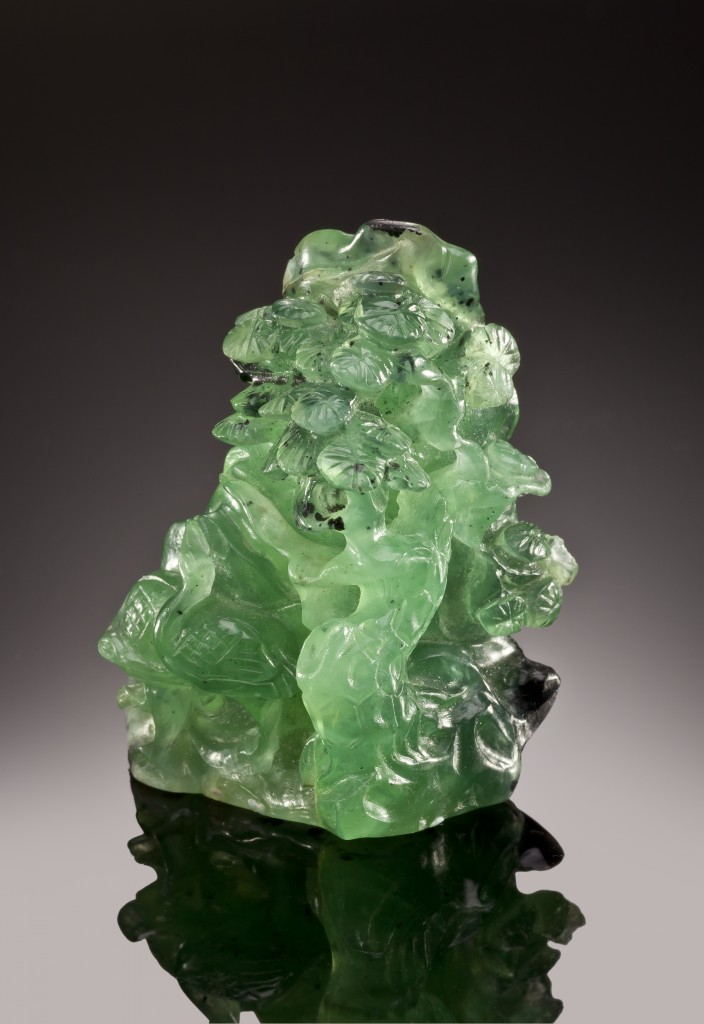
Show Life Size
Carved Williamsite
This image is copyrighted. Unauthorized reproduction prohibited.
| Gem Origin: | Line pit (Lowe's Mine), Cecil County, Maryland, USA |
|---|---|
| Artist/Creator: | Chinese carver |
| Gemstones: | Williamsite, Antigorite, Serpentine |
| View User Page & Photos | View Williamsite Gallery | Light Background |

--------------------------------------
A bit of personal history on my own love affair with williamsite and this piece:
As a friend of the landowner during the mid-1980's, I collected pieces of the translucent emerald-green williamsite at the Line Pit property just inside the Maryland side of the MD/PA state line -- (Isaac Tyson, Jr's primary chromite mine in the mid-1800s, though first mined by Lowe before 1838 on the Pennsylvania side of the border). Lowe's Pit is apparently connected to the Line Pit shaft 60 feet away (at a depth of 92 feet) by a southeasterly trending inclined shaft. The massive chromite podiform ore-body was said to have been sheathed in a thin shell of the williamsite, which then graded into the common serpentine host rock around the ore body.
I had seen my first fingernail-sized piece of beautiful green williamsite imbedded in fresh asphalt paving in a new parking lot on Aberdeen Proving Ground, Maryland, as I stepped out of my car on a torrid day in the summer of 1981. After prying the tiny piece out with a key (the asphalt was warm and soft), I asked around over several months and was told that it was a prized local Maryland material -- williamsite -- probably from crushed serpentine rock from Cedar Hill quarry. I was hooked! Soon I had purchased copies of the more prominent references to chromite deposits in Maryland and Pennsylvania and decided to search for the Line Pit deposit, as many of the mineral clubs in the MD/PA had collected there in the '50s - '70s. The day I first visited in winter 1981, I did spot a nice piece under a half-inch of ice on the entrance path. The wetted piece I chipped from the iced-over puddle was beautiful emerald green and has been in my display case ever since. I was also met from behind by the shotgun of the landowner who had seen my car parked just off the road nearby and came to find me. As there were no "No Trespassing" signs posted in the brushy thicket around the path area at that time, the owner gave me a reprieve and I was careful to seek permission during the following 4 years of collecting trips. The material was hard to find as almost all the mine dump had been hauled off for road ballast -- apparently in the '50s or a bit later -- and grasses, trees, briars, and poison ivy had long-since taken over. The area is no longer accessible.
By almost unbelievable coincidence, besides finding the correct mine on that first trip, and surviving a shotgun challenge as I picked up my first piece of williamsite, I also purchased a Baltimore-published 1839 copy of "Josephus" at a flea market in the area on the way home late that afternoon; inside the cover was an inscription presenting the copy to Jesse Tyson, then age 18, from his father Isaac Tyson, Jr., in "Cold Stream," MD (NE Baltimore) in 1844. I had found the mine, found nice williamsite, gained collecting permission, and found the famous owner's (Isaac Tyson Jr.'s) 1844 gift copy of Josephus to his son Jesse -- all on one wintry-afternoon's exploration trip.
One of my best smaller "show-and-tell" williamsite pieces was in my pocket when I attended the Tucson Gem and Mineral Show in the early '90s. It passed across the counter to the hand of an Asian mineral dealer, who soon passed it to a carver in Taiwan, who then passed it back to me in a simple padded mailer envelope 2 months later, with a bill for $40 for having carved it. That carved piece (5 x 4 x 3 cm) pictured here is one of my most-treasured mineral specimens. The actual brightness, translucency, and color are stunning, and the identification of the piece as serpentine/antigorite, var. williamsite, fools almost everyone. There is no fibrous nature or "undercutting" with this piece (and most of my other pieces), as is common with more-typical antigorite samples from other chromite deposits in the State Line area.
You can imagine my total shock when I learned years later that Maryland changed the experts'-consensus designation of "Maryland's gemstone" to a drab river agate -- a tragedy, as this photo of what I consider to be Maryland’s TRUE gemstone -- williamsite -- clearly shows
This photo has been shown 2588 times